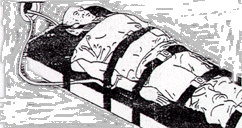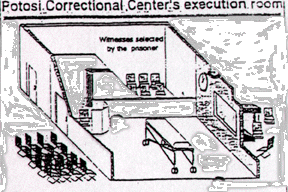Editors note:
State prison officials have declined to discuss their execution procedures, detailed by british filmmaker Stephen Trombley in his 1992 book titled "The Execution Protocol." Based on that book and other globe research here's an insight into the protocol. Written by Jim Suhr, Globe Staff Writer
Since 1989, 11 inmates in Missouri have been put todeath by lethal injection. In October, Alan Bannister figures to become the 12th.
Condemned in 1983 for the shooting death of a man near Joplin. Bannister is grim about his prospects of dodging the so-called Missouri Protocol, the process by which he might be executed.
In Missouri, death warrants often are issued 10 days before a scheduled execution. Protocol says the condemned person be taken to the deathwatch or holding cell 48 hrs before execution, barring factors requiring immediate isolation. The 48 hrs is the minimum time a condemned man would spend on deathwatch.
During deathwatch, an officer supervises the condemned person 24 hours a day, logging all visitors and events. In Missouri deathwatch inmates have free soft drinks, snacks and cigarettes. Most inmates spend their last hours viewing videotapes. They also may make collect telephone calls with prior approval of the operations officer, who logs calls.
Deathwatch inmates may have visitors from 6 a.m. to 10 p.m. On the execution night, visiting hours end at 6 p.m. Two visitors are allowed at any time with the inmate. Who may receive visits from up to two clergymen.
At least 48 hours before the execution, the prison doctor is notified. The inmate is given a physical examination 24 hours before being executed.
Then the countdown begins:
6:15pm - Prison workers man their posts.
7pm - The execution room's telephones are checked. Clocks are synchronzed with one in the media room.
7:30pm - The inmate is given clean clothing and offered a sedative. A certified operator verifies the readiness of the lethal-injection machine, which will administer to the inmate separate, lethal doses of three chemicals.
First drug - Sodium Pentathol (causes unconsciousness) Ultra short acting barbituate. Medical uses: Used as anesthesia in lower levels with other drugs. Works on areas of the brain dealing with consciousness.
second drug - Pancuronium Bromide (causes paralysis) Blocks ability of nerves to contract voluntary muscles (face, hands, and lungs). The heart, an involuntary muscle is not affected. Medical uses: muscle relaxant during surgery.
Third drug - Potassium Chloride (stops the heart) Chloride is vehicle for potassium, which affects electrical impulses conducted through heart muscles. Lethal dose shuts down electrical activity, causing cardiac arrest. Medical uses: Potassium is necessary at sub lethal levels for proper cell function. It is one of the most abundant substances in cells.
8:30pm - The death chamber's gurney is prepared.
10pm - During the previous 90 minutes, telephones and clocks have been rechecked, as has execution machine. The exectuion team meets in the death chamber, and the drugs are loaded. For security, six key members of the exectuion team wear highest priority badges. Other staff wear badges identifying them for duty at various security levels in the prison and its perimeter.
10:30pm - The chaplain goes to the holding cell. An ambulance and hearse arrive. Telephone are manned. State witnesses report to the employees' entrance. Missouri law requires a minimum of 12 state witnesses, six of whom often are reporters.
10:45pm - State witnesses report to the hearing room.
11pm - The state Division of Adult Instructions director goes to the hearing room. The deputy director monitors an open telephone line to the attorney general.
11:10pm - Telephone lines are tested.
11:15pm - The doctor tests the electocardiogram equipment.
11:20pm - The department director monitors all telephone lines, carrying a portable radio as a backup. Clocks are rechecked.
11:30pm - The director calls a govenor's representative to check if there is any stay. An assistant superintendent ensures that only authorized personnel are in the execution area.
11:35pm - The inmate is strapped to the gurney. The EKG is attached. The intravenous line set. A catheter and anal plug are inserted into the inmate, his arms strapped to his side, is covered from the neck down with a sheet.

11:40pm - Telephones are manned with the arrival of up to five witnesses tabbed by the inmate. Each witness is subject to a separate security procedure and is separated from state witnesses.
12pm - The department director calls the superintendent to ask if there is a stay of execution. If not, the superintendent proceeds. The exectuion chamber's blinds are opened to the witnesses.

12:01pm - The superintendent reads the death warrant. The execution begins with the first intravenous dose of three chemicals.
Each event is timed and logged by an officer in the chamber. The doctor monitors the EKG and signals to the officer when the inmates's heart stops.